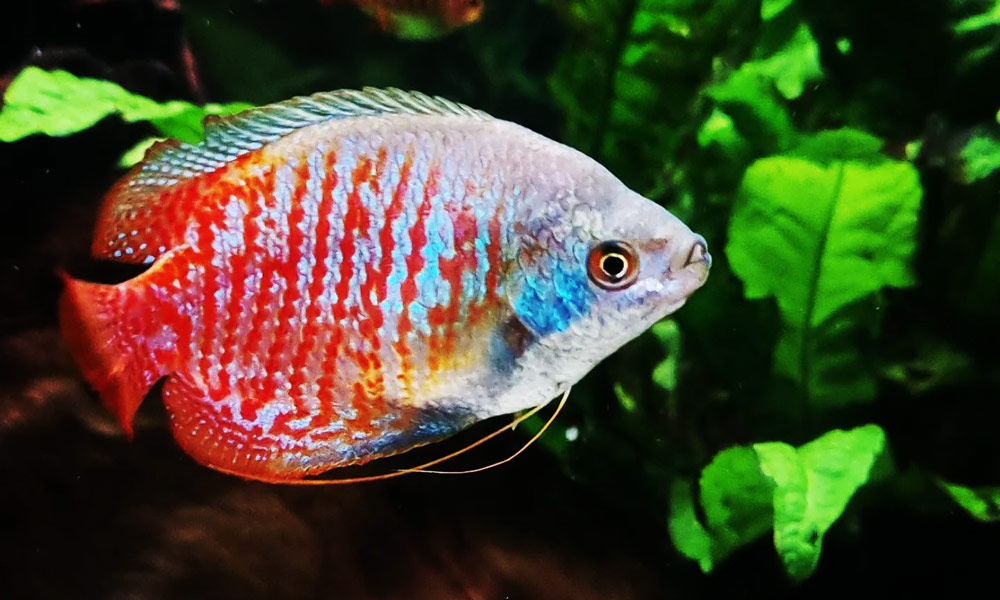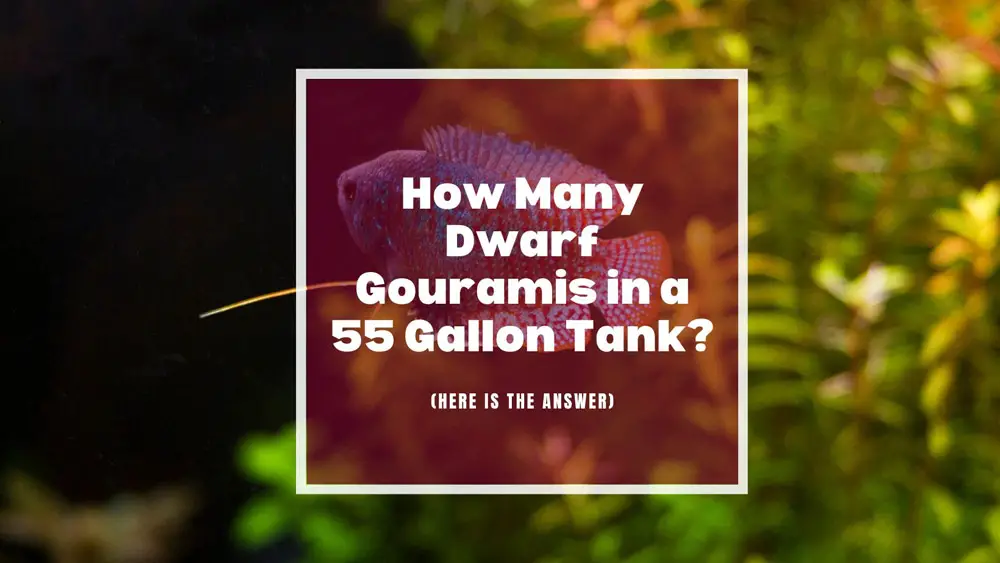Virtually every fish owner has asked the most common but hardest question, “How many fish can I put in an X-gallon tank?” including myself. When it comes to the most popular aquarium size and the great beginner centerpiece fish, the question “how many dwarf gouramis can I put in a 55-gallon tank?” is bound to come up.
Sooner or later, the widely known rule “one inch per gallon” will show up. You did the simple math, and viola! You have your answer… right?
Wrong!
The rule of thumb overly simplifies the stocking process and often gives false information, especially for new fish tank owners.
In this article, let’s use the question “How many dwarf gouramis in a 55 gallon tank?” as an example to try to find the real answer and learn about the correct stocking process along the way.
The Debate of The One Inch Fish Per Gallon Rule
The debate over the most widely known rule “one inch per gallon” has been going on for years in the aquarium community.
Some hobbyists believe this rule is complete nonsense and shouldn’t be followed at all, while others (including myself) think that it’s a decent starting point but definitely not the gospel truth.
For a general estimate, the max size of dwarf gourami is about 3.5 inches (8.9 cm), which would make the maximum number of fish 15 in a 55-gallon tank according to this rule.
Does this sound right? I sure hope not. IMHO this is where the debate begins – people taking the word rule too literally. When you’re on the fence, think about how many fish your fish tank can safely hold without knowing the variables, this general rule works as a rough estimate.
But that’s all it is – a starting point. You should never rely on it to make decisions.
Now that we know this rule is not the end-all-be-all, how to determine how many fish your tank will hold safely? Here is the process that I use and recommend.
How Many Dwarf Gouramis in A 55 Gallon Tank?
There is definitely more homework first before you head to the store, but it helps you determine the actual number of dwarf gouramis in your tank and save you a lot of headaches (and fish) in the long run.

Learn About Fish
The first thing you need to do is to learn about the fish species that you want to keep in your aquarium. Not all fish are created equal – they come in different genera, habitats, sizes, and, most importantly, behaviors and personalities. Some fish are peaceful while some others can be real jerks.
Knowing about their temperament and behaviors is crucial to stocking your tank correctly; there is no way around it.
Do your research and learn everything you can about them – their natural habitat, preferred water parameters, social behavior, diet, aggression level, etc. The more you know about a fish species, the easier it will be to provide them with the necessary environment and care in your aquarium.
For our example, let’s take a look at the dwarf gourami(Trichogaster lalius).
Dwarf Gourami Specie Profile
| Family: | Osphronemidae (labyrinth fish) |
| Genus: | Trichogaster |
| Scientific name: | Trichogaster lalius |
| Origin: | South Asia Bangladesh, India, and Pakistan |
| Habitat: | Slow-moving waters with heavy vegetation; avoid strong currents |
| Max Size: | 3.5 inches (8.8cm) |
| Lifespan: | 3-5 years |
| Water Temperature: | 72 – 82°F (22 – 27°C) |
| ph: | 6.0 – 7.5 |
| Hardness: | 2 – 18°H |
| Salinity: | Freshwater |
| Diet: | Omnivore |
| Level: | Top-middle dweller |
| Temperament: | Not the “ideal” community fish. Generally peaceful, but males are territorial. Two males will fight in small tanks. |
| Behaviors: | Live in trios, with one male and two females. Pairs will swim together. Very skittish fish; can be stressed out by loud noise. |
| Tankmates: | Peaceful middle to bottom dwelling fish. |
| Breeding: | A bubble nest builder, avoid strong filtration |
| Note: | Over 22% of dwarf gouramis come out of fish farms in Singapore were carrying the fatal Dwarf Gourami Disease (also called Dwarf Gourami Iridovirus) |
Fish Size
This is because fish we purchase from the store are usually juvenile and have not yet reached their full size potential.
Dwarf gouramis can grow up to 3.5 inches (8.8 cm). But these fish can be as small as an inch in length when sold. The one-inch-per-gallon rule can apply to these juveniles. But obviously, it’s not going to be accurate for their mature size. That’s a big difference.
Behavior & Temperament
Furthermore, it’s generally hard to tell the gender of most fish when they are young, including the dwarf gouramis. The behavior of juvenile fish can be very different from its adult counterparts. Juvenile gourami might be shy and peaceful. But when they mature, males can become aggressive and territorial towards their own species.
You can imagine what will happen if you put two male or a pair of dwarf gouramis in a 10-gallon tank based on the one-inch-per-gallon rule – a bloodbath waiting to happen, especially when they are ready to breed.
Another thing to consider is that most fish are social creatures. They live in groups in the wild and prefer to do so to feel safe in captivity as well.
This is especially true for labyrinth fish like dwarf gouramis. These fish live in trios in nature, consisting of one male and two females. They will get stressed out and sick if they are kept alone.
Different Levels of Fish
A community aquarium is a happy mix of different species of fish occupying different levels in the tank. There are top-dwelling, middle-dwelling, and bottom-dwelling fish.
Dwarf gouramis are considered top to middle dwellers. They prefer to swim around in the middle and upper regions of the aquarium.
If you have a lot of top-dwelling fish, they might outcompete the dwarf gouramis for food. Or the dwarf gouramis might feel stressed out from all the activity happening at the top of the tank.
Bioload in Aquarium
The next thing you need to take into account is the bioload (or waste load) of your aquarium. In the natural, new water is constantly being cycled in, and old water is being flushed out, so the fish waste doesn’t have a chance to accumulate and pollute the water.
In the home aquarium, we have to do our best to replicate this process with a filtration system. But there is no such thing as a “perfect” filtration system. As a result, the bioload of your aquarium should be considered when stocking it with fish.
Putting so many fish in an aquarium and the filtration system might be unable to handle it, leading to water quality issues.
Along with not putting so many fish in an aquarium, leading to water quality issues, there are many ways to help reduce the bioload.
Filtration
Beneficial bacteria will live in your aquarium filter and help to break down the ammonia produced by the fish into less harmful nitrates. The more fish you have in your aquarium, the more ammonia will be produced, and the more beneficial bacteria will be needed to break it down.
So make sure you have a good filtration system in place. For a new fish tank, make sure it’s fully cycled before adding any fish.
Let’s go back to the example of the dwarf gouramis stocking number. Since these fish prefer slow-moving waters, strong currents from filters can be stressful for them. Therefore, you might want to reduce the number of fish in your aquarium to help reduce the bioload in your aquarium.
Aquarium Plants
Live aquarium plants are beautiful and satisfying. They also absorb the ammonia and nitrates produced by the fish and use them as nutrients, which helps keep the water quality in your aquarium high and reduces the amount of work your filtration system has to do.
Both root and float plants are a must for dwarf gouramis because they provide a stimulating environment for your fish, and males will use bits of plants to build bubble nests.
Tank Maintenance

It’s simple. The more fish you have, the more work you have to do to maintain the water quality in your aquarium. This means more water changes, more vacuuming, and more monitoring.
If you don’t want to spend much time on tank maintenance, keeping fewer fish is best.
In order to keep your dwarf gouramis happy and healthy, I highly recommend investing in an accurate freshwater water test kit. Personally, I like the API Freshwater Master Test Kit, as I always found their test results to be very accurate. Plus, it comes with a handy color chart that makes it easy to understand your water quality results.
So, how many dwarf gouramis can you have in a 55-gallon tank? I can only give you a general answer according to my experience. I would say you could have four dwarf gouramis in a 55 gallons (48″ x 21″ x 12″ ) fish tank, with only one male and three females. But it depends on the other factors we have discussed, such as the other fish in your aquarium, the plants, the filtration system, and your maintenance routine.
Putting It All Together
To sum it up, when stocking your aquarium with dwarf gouramis, you need to consider the different levels of fish, the bioload of your aquarium, the filtration system, live plants, and your aquarium maintenance routine. Based on these factors, you can determine how many dwarf gouramis (or any fish) you can have in your aquarium.
Do you have any experience with dwarf gouramis? How many fish do you have in your X-gallon tank? And what other kinds of fish do you have? We would love to hear your stories and experiences in the comments below.
If you liked this article, please share it with your friends!





